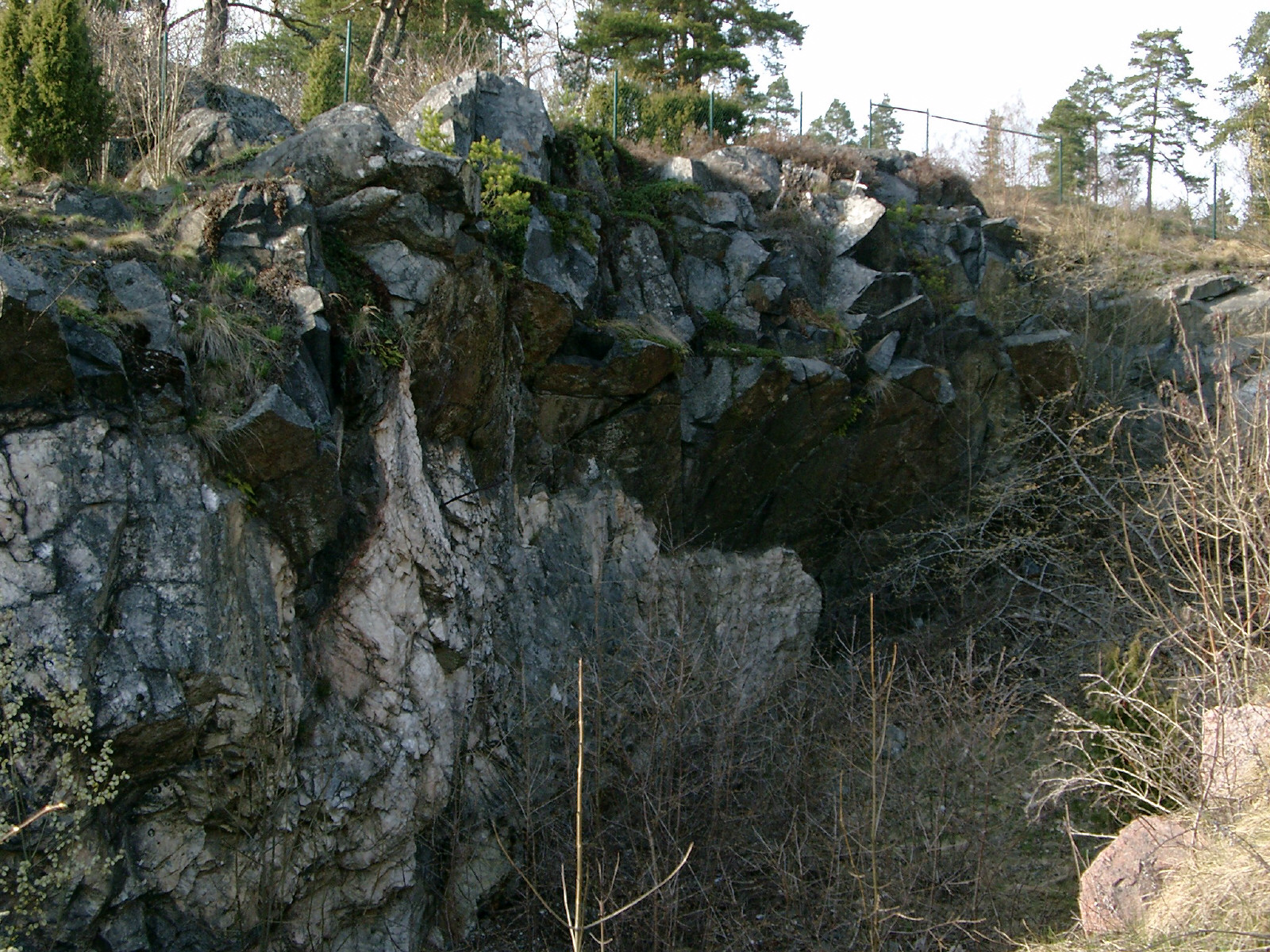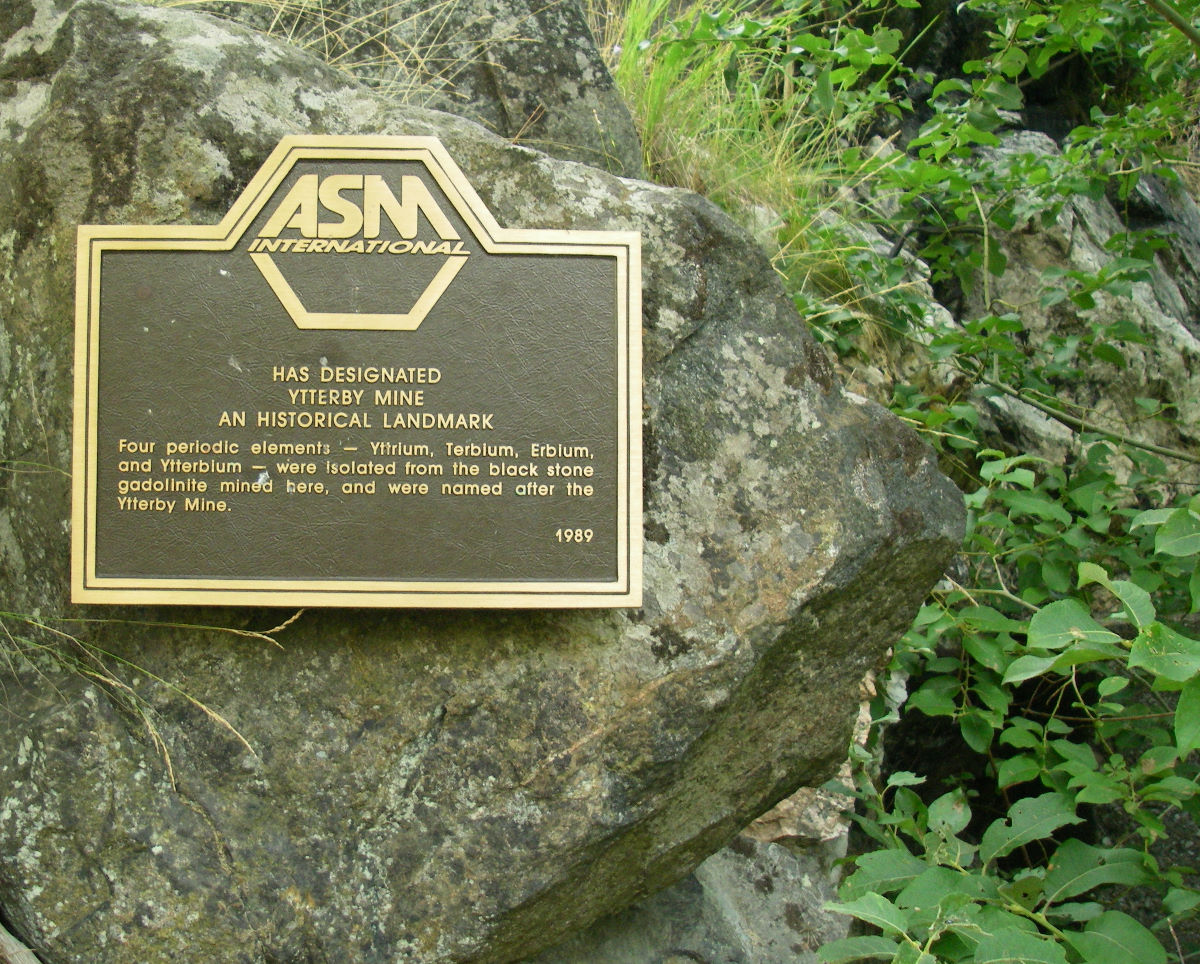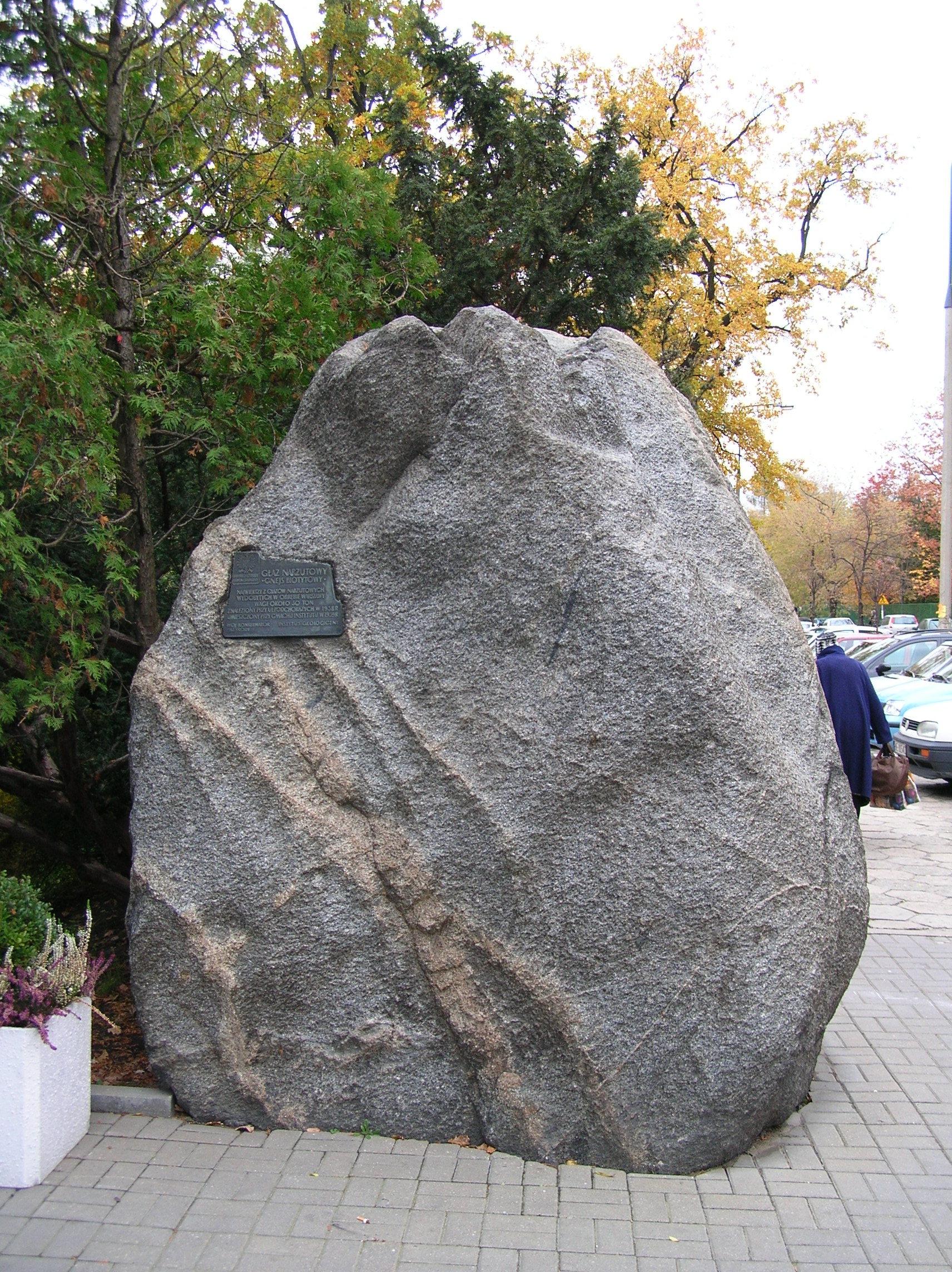|
Ytterby, Sweden
Ytterby () is a village on the Swedish island of Resarö, in Vaxholm Municipality in the Stockholm archipelago. Today the residential area is dominated by suburban homes. The name of the village translates to "outer village". Ytterby is perhaps most famous for being the single richest source of elemental discoveries in the world; the chemical elements yttrium (Y), terbium (Tb), erbium (Er), and ytterbium (Yb) are all named after Ytterby, while four more elements were first discovered there. Mine Quartz was mined in the area beginning in the 1600s for the ironworks in Uppland. Feldspar was mined for local porcelain manufacture, such as Gustavsberg, and the porcelain trade with Britain and Poland. The mine is likely the first feldspar mine in Sweden, starting in 1790. Feldspar mining was likely sporadic and based on manufacture demand. This demand took off in the 1860s, leading to deeper mining efforts at Ytterby. The mine became one of the most productive quartz and feldspar ... [...More Info...] [...Related Items...] OR: [Wikipedia] [Google] [Baidu] |
Ytterby Gruva 2769
Ytterby () is a village on the Swedish island of Resarö, in Vaxholm Municipality in the Stockholm archipelago. Today the residential area is dominated by suburban homes. The name of the village translates to "outer village". Ytterby is perhaps most famous for being the single richest source of elemental discoveries in the world; the chemical elements yttrium (Y), terbium (Tb), erbium (Er), and ytterbium (Yb) are all named after Ytterby, while four more elements were first discovered there. Mine Quartz was mined in the area beginning in the 1600s for the ironworks in Uppland. Feldspar was mined for local porcelain manufacture, such as Gustavsberg, and the porcelain trade with Britain and Poland. The mine is likely the first feldspar mine in Sweden, starting in 1790. Feldspar mining was likely sporadic and based on manufacture demand. This demand took off in the 1860s, leading to deeper mining efforts at Ytterby. The mine became one of the most productive quartz and feldspar ... [...More Info...] [...Related Items...] OR: [Wikipedia] [Google] [Baidu] |
Sweden
Sweden, formally the Kingdom of Sweden,The United Nations Group of Experts on Geographical Names states that the country's formal name is the Kingdom of SwedenUNGEGN World Geographical Names, Sweden./ref> is a Nordic country located on the Scandinavian Peninsula in Northern Europe. It borders Norway to the west and north, Finland to the east, and is connected to Denmark in the southwest by a bridgetunnel across the Öresund. At , Sweden is the largest Nordic country, the third-largest country in the European Union, and the fifth-largest country in Europe. The capital and largest city is Stockholm. Sweden has a total population of 10.5 million, and a low population density of , with around 87% of Swedes residing in urban areas in the central and southern half of the country. Sweden has a nature dominated by forests and a large amount of lakes, including some of the largest in Europe. Many long rivers run from the Scandes range through the landscape, primarily ... [...More Info...] [...Related Items...] OR: [Wikipedia] [Google] [Baidu] |
Scandium
Scandium is a chemical element with the symbol Sc and atomic number 21. It is a silvery-white metallic d-block element. Historically, it has been classified as a rare-earth element, together with yttrium and the Lanthanides. It was discovered in 1879 by spectral analysis of the minerals euxenite and gadolinite from Scandinavia. Scandium is present in most of the deposits of rare-earth and uranium compounds, but it is extracted from these ores in only a few mines worldwide. Because of the low availability and difficulties in the preparation of metallic scandium, which was first done in 1937, applications for scandium were not developed until the 1970s, when the positive effects of scandium on aluminium alloys were discovered, and its use in such alloys remains its only major application. The global trade of scandium oxide is 15–20 tonnes per year. The properties of scandium compounds are intermediate between those of aluminium and yttrium. A diagonal relationship exists betwee ... [...More Info...] [...Related Items...] OR: [Wikipedia] [Google] [Baidu] |
ASM International (society)
ASM International, formerly known as the American Society for Metals, is an association of materials-centric engineers and scientists. ASM provides several information resources, including technical books, various digital databases, and ASM Handbooks, a series of reference books that cover a range of topics and contain peer-reviewed information. These handbooks are recognized as a standard reference in the field of materials science. Examples of topics covered by the ASM Handbooks are mechanical properties of metals, corrosion studies, failure analysis, materials characterization, and much more. Other publications include technical journals such as Journal of Thermal Spray Technology and Journal of Materials Engineering and Performance. ASM also hosts numerous international conferences each year, including ASM's Annual Meeting: International Materials, Applications, and Technologies Conference and Exposition (IMAT). Six affiliate societies focused on specific areas of materials ... [...More Info...] [...Related Items...] OR: [Wikipedia] [Google] [Baidu] |
Gadolinite
Gadolinite, sometimes known as ytterbite, is a silicate mineral consisting principally of the silicates of cerium, lanthanum, neodymium, yttrium, beryllium, and iron with the formula . It is called gadolinite-(Ce) or gadolinite-(Y), depending on the prominent composing element (Y if yttrium predominates, and Ce if cerium). It may contain 35.5% yttria sub-group rare earths, 2.2% ceria earths, as much as to 11.6% BeO, and traces of thorium. It is found in Sweden, Norway, and the US (Texas and Colorado). Characteristics Gadolinite is fairly rare and typically occurs as well-formed crystals. It is nearly black in color and has a vitreous luster. The hardness is between 6.5 and 7 on the Mohs scale, and the specific gravity is between 4.0 and 4.7. It fractures in a conchoidal pattern and streaks grayish-green. It was also thought to exhibit pyrognomic properties, as it can emit visible light when heated to relatively low temperatures, but the scientific consensus is that this is the p ... [...More Info...] [...Related Items...] OR: [Wikipedia] [Google] [Baidu] |
Anders Gustaf Ekeberg
Anders Gustaf Ekeberg (Stockholm, Sweden, 16 January 1767 – Uppsala, Sweden, 11 February 1813) was a Swedish analytical chemist who discovered tantalum in 1802. - subscription required He was notably deaf. Education Anders Gustav Ekeberg was a Swedish scientist, mathematician and expert in Greek literature. His father, Joseph Erik Ekeberg, was a shipbuilder. His uncle was Carl Gustaf Ekeberg. Anders Gustav Ekeberg attended school at Kalmar, Söderåkra, Vestervik, and Karlskrona. He was a gifted student and enrolled at Uppsala University in 1784, graduating in 1788. His thesis addressed the extraction of oils from seeds. In 1789 and 1790, he traveled and studied in Germany, hearing Martin Heinrich Klaproth lecture in Berlin as well as Christian Ehrenfried Weigel in Greifswald. Career In 1794, Anders Gustav Ekeberg began teaching at Uppsala. He was a supporter of Antoine Lavoisier's proposals for systematizing chemical nomenclature. In 1795 he and Pehr von Afzelius pub ... [...More Info...] [...Related Items...] OR: [Wikipedia] [Google] [Baidu] |
Johan Gadolin
Johan Gadolin (5 June 176015 August 1852) was a Finnish chemist, physicist and mineralogist. Gadolin discovered a " new earth" containing the first rare-earth compound yttrium, which was later determined to be a chemical element. He is also considered the founder of Finnish chemistry research, as the second holder of the Chair of Chemistry at the Royal Academy of Turku (or ''Åbo Kungliga Akademi''). Gadolin was ennobled for his achievements and awarded the Order of Saint Vladimir and the Order of Saint Anna. Early life and education Johan Gadolin was born in Åbo (Finnish name Turku), Finland (then a part of Sweden). Johan was the son of Jakob Gadolin, professor of physics and theology at Åbo. Johan began to study mathematics at the Royal Academy of Turku (''Åbo Kungliga Akademi'') when he was fifteen. Later he changed his major to chemistry, studying with Pehr Adrian Gadd, the first chair of chemistry at Åbo. In 1779 Gadolin moved to Uppsala University. In 1781, he ... [...More Info...] [...Related Items...] OR: [Wikipedia] [Google] [Baidu] |
Carl Axel Arrhenius
Carl Axel Arrhenius (29 March 1757 – 20 November 1824) was an officer in the Swedish army as well as an amateur geologist and chemist. He is best known for his discovery of the mineral ytterbite (later called gadolinite) in 1787. The discovery of ytterbite was the first step in identifying an entire group of previously unknown elements, the rare earths. Eight stable rare earth elements were eventually extracted from ytterbite: terbium, dysprosium, holmium, erbium, thulium, ytterbium, lutetium, and yttrium. Early life Arrhenius was born in Stockholm on 29 March 1757 to Jakob Larsson Arrhenius and Brita Sofia Georgii. In 1796 he married Gustafva von Bilang. Career Arrhenius became a lieutenant of the Svea Artillery Regiment of the Swedish army, the regiment being stationed in Vaxholm. As an artillery officer, Arrhenius was assigned to study the characteristics of gunpowder at the Swedish Royal Mint's (Kungliga Myntet) laboratory. Being taught to test gunpowder b ... [...More Info...] [...Related Items...] OR: [Wikipedia] [Google] [Baidu] |
Greensand (geology)
Greensand or green sand is a sand or sandstone which has a greenish color. This term is specifically applied to shallow marine sediment that contains noticeable quantities of rounded greenish grains. These grains are called ''glauconies'' and consist of a mixture of mixed-layer clay minerals, such as smectite and glauconite. Greensand is also loosely applied to any glauconitic sediment. Formation Greensand forms in anoxic marine environments that are rich in organic detritus and low in sedimentary input. Having accumulated in marine environments, greensands can be fossil-rich, such as in the late-Cretaceous deposits of New Jersey. Occurrence Important exposures are known from both northern and western Europe, North America, southeastern Brazil and north Africa. Well known and important greensands are the Upper and Lower Greensands of England and occur within Eocene and Cretaceous sedimentary strata underlying the coastal plains of New Jersey and Delaware. Although greensand has ... [...More Info...] [...Related Items...] OR: [Wikipedia] [Google] [Baidu] |
Graphic Granite
Graphics () are visual images or designs on some surface, such as a wall, canvas, screen, paper, or stone, to inform, illustrate, or entertain. In contemporary usage, it includes a pictorial representation of data, as in design and manufacture, in typesetting and the graphic arts, and in educational and recreational software. Images that are generated by a computer are called computer graphics. Examples are photographs, drawings, line art, mathematical graphs, line graphs, charts, diagrams, typography, numbers, symbols, geometric designs, maps, engineering drawings, or other images. Graphics often combine text, illustration, and color. Graphic design may consist of the deliberate selection, creation, or arrangement of typography alone, as in a brochure, flyer, poster, web site, or book without any other element. The objective can be clarity or effective communication, association with other cultural elements, or merely the creation of a distinctive style. Graphics ... [...More Info...] [...Related Items...] OR: [Wikipedia] [Google] [Baidu] |
Aplite
Aplite () is an intrusive igneous rock in which the mineral composition is the same as granite, but in which the grains are much finer, under 1 mm across. Quartz and feldspar are the dominant minerals. The term ''aplite'' or ''aplitic'' is often used as a textural term to describe veins of quartz and feldspar with a fine to medium-grain "sugary" texture. Aplites are usually very fine-grained, white, grey or pinkish, and their constituents are visible only with the help of a magnifying lens. Dykes and veins of aplite are commonly observed traversing granitic bodies; they occur also, though less frequently, in syenites, diorites, quartz diabases, and gabbros. Aplites usually have a genetic affinity to the rocks they intrude. The aplites of granite areas, for example, are the last part of the magma to crystallize, and correspond in composition to the quartzo-feldspathic aggregates that fill up the spaces between the early-formed minerals in the main body of the rock. They ... [...More Info...] [...Related Items...] OR: [Wikipedia] [Google] [Baidu] |
Almqvist & Wiksell
Almqvist & Wiksell is a former Swedish printing and publishing company. Since 1990 it is a trademark owned by the publishing company Liber. Almqvist & Wiksell originated from the acquisition of the Uppsala company Edquist & Berglunds tryckeri by Robert Almqvist (1857–1938) and Julius Wiksell (1855–1897).Nationalencyklopedin ''Nationalencyklopedin'' (; "The National Encyclopedia" in English), abbreviated NE, is a comprehensive contemporary Swedish-language encyclopedia, initiated by a favourable loan from the Government of Sweden of 17 million Swedish kronor in 19 ..., Almqvist & Wiksell Tryckeri AB. http://www.ne.se/uppslagsverk/encyklopedi/lång/almqvist-wiksell-tryckeri-ab (retrieved 02-09-2022) References Book publishing companies of Sweden Mass media in Uppsala Publishing companies established in 1882 1882 establishments in Sweden {{publish-company-stub ... [...More Info...] [...Related Items...] OR: [Wikipedia] [Google] [Baidu] |



-252549.jpg)
-244305.jpg)

